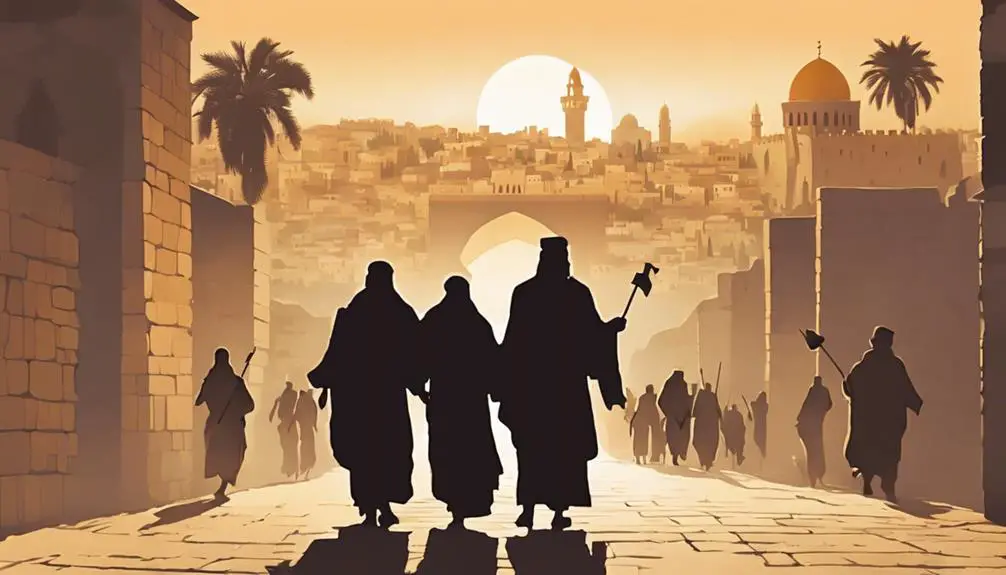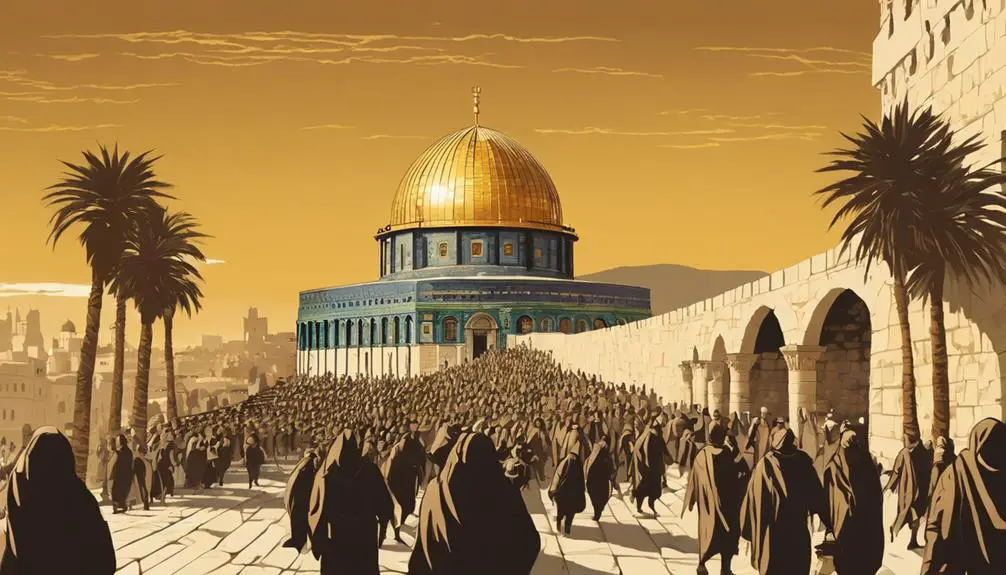Travel through biblical narratives to uncover the profound significance of pilgrimage, revealing its impact on faith and spiritual journeys today.

Pilgrimage in the Bible
Just as Moses led the Israelites through the desert, you're about to embark on a journey exploring the significance of pilgrimage in the Bible.
You'll uncover the roots of these sacred travels, from the arduous journey of the Israelites in Exodus to the spiritual treks taken by Jesus and his followers.
Along the way, you'll discover how these ancient voyages shape modern practices of faith.
But as we set off, keep in mind, the true destination of any pilgrimage isn't just a place on a map—it's a deeper understanding of faith itself.
What will you uncover as we traverse these sacred paths together?
Key Takeaways
- Biblical narratives, like Moses' Exodus, illustrate the transformative power of pilgrimage in uniting and spiritually elevating a community.
- Pilgrimages in the Bible symbolize deep faith, with sacred journeys reflecting a pursuit of divine favor and presence.
- Jesus' pilgrimages were foundational to His ministry, emphasizing life as a spiritual journey and offering profound theological insights.
- Historical and biblical contexts of pilgrimage highlight its role in shaping communal identity and fostering spiritual unity.
The Genesis of Pilgrimage

The concept of pilgrimage, deeply rooted in human spirituality and culture, finds its earliest biblical manifestations in the journeys of the patriarchs, which not only underscored their faith but also laid the groundwork for subsequent religious voyages. These ancient practices, embedded within the fabric of early religious narratives, illustrate a profound connection between the act of pilgrimage and the pursuit of divine favor or enlightenment. You're drawn into a world where sacred destinations weren't merely locations but were imbued with profound spiritual significance.
As you delve deeper, you'll find that these journeys weren't aimless wanderings but deliberate acts of faith, signifying a physical manifestation of the spiritual quest for understanding and closeness to the divine. These patriarchal narratives serve as the archetypes of pilgrimage, embedding within them the foundational elements that characterize later religious pilgrimages: the setting apart from ordinary life, the journey towards a sacred destination, and the transformative experience therein.
Understanding these ancient practices offers you a lens through which to view the evolution of pilgrimage across cultures and religions. It highlights the universality of the human quest for spiritual connection and the role of sacred destinations in facilitating this timeless journey.
Exodus: A Journey of Faith
Building on the understanding of ancient pilgrimage practices, you'll now explore how the Exodus narrative epitomizes a collective journey of faith, marking a pivotal moment in the spiritual and physical odyssey of the Israelites. Through Moses' leadership, the Israelites embarked on a transformative pilgrimage, not just in location but in faith and identity. This journey was met with Pharaoh's defiance, challenging the Israelites' resolve and faith in their God.
Element |
Significance |
Outcome |
|---|---|---|
Moses' Leadership |
Embodied guidance and unwavering faith, directing the Israelites. |
United and motivated people |
Pharaoh's Defiance |
Represented monumental external opposition, testing resilience. |
Strengthened collective faith |
Red Sea Crossing |
Symbolic act of divine intervention, marking a new beginning. |
Solidified belief in divine protection |
Sinai Covenant |
Establishment of a sacred agreement, defining identity and faith. |
Bonded the community spiritually |
Analytically, you'll notice that the Exodus isn't just a story of movement from one geographical location to another; it's a profound narrative of faith's journey. Each step, guided by Moses against Pharaoh's defiance, was a test and affirmation of their belief system. This sacred pilgrimage reshaped their communal and individual identities, setting a precedent for spiritual journeys in the biblical narrative.
Festivals and Holy Journeys

In exploring biblical narratives, it's crucial to examine how festivals and holy journeys further illuminate the spiritual dynamics of ancient Israelite society. These events weren't just mere gatherings; they were deeply imbued with ritual significance, binding the community to their faith and to each other. Sacred spaces became the focal points for these congregations, serving not only as physical locations but as symbols of divine presence and promise.
The pilgrimage to these sacred spaces during major festivals served multiple purposes:
- Unity: Bringing together disparate groups within the faith, fostering a sense of belonging and community.
- Remembrance: Acting as a living memory of divine acts and promises, ensuring that stories of faith were passed down through generations.
- Sacrifice: Demonstrating devotion through the physical and spiritual act of journeying, often coupled with offerings.
- Purification: Offering opportunities for spiritual cleansing and renewal, aligning individual and communal lives with divine will.
- Education: Serving as a formative experience for the young, embedding them within the narrative of their faith through firsthand experience.
These elements combined to make festivals and holy journeys not just important events, but central pillars of ancient Israelite identity and spirituality.
Jesus and Pilgrimage
Many narratives within the New Testament highlight Jesus' engagement with pilgrimage, showcasing how these journeys weren't only integral to His ministry but also served as pivotal moments for theological reflection and teaching. Through His travels, Jesus' teachings often unfolded in the context of movement, emphasizing the notion of life itself as a spiritual journey. These passages invite you to see pilgrimage not just as a physical endeavor but as an evolving path of faith and understanding.
Jesus' pilgrimages, ranging from His baptism in the Jordan River to His final journey to Jerusalem, are rich with symbolic acts and teachings that underscore the importance of journeying towards spiritual enlightenment. His encounters, parables, and miracles along these routes provided profound insights into the nature of faith, discipleship, and the Kingdom of God. For instance, consider how Jesus' walk to Emmaus after His resurrection becomes a metaphor for spiritual awakening, illustrating how true understanding often unfolds gradually along the journey of faith.
Modern Pilgrimages: Echoes of the Past

Reflecting on Jesus' pilgrimages reveals how modern journeys of faith continue to draw inspiration from these biblical narratives, embodying the timeless quest for spiritual depth and understanding. In this digital age, the concept of pilgrimage has evolved, yet the essence remains unchanged. Virtual pilgrimages allow individuals to embark on spiritual journeys without leaving their homes, offering a unique blend of tradition and technology.
Meanwhile, pilgrimage tourism has become a significant aspect of the global travel industry, with millions visiting sacred sites yearly, seeking personal transformation and a deeper connection with the divine.
- Virtual pilgrimages bring the sacred to our screens, offering a solace that transcends physical boundaries.
- The Yearning for Authenticity drives many to walk ancient paths, tracing the steps of ancestors and prophets.
- Pilgrimage tourism revitalizes local economies, but also prompts introspection on the commercialization of the sacred.
- The Collective Experience of pilgrims fosters a profound sense of unity and shared humanity.
- Environmental Consciousness is growing among modern pilgrims, who seek to tread lightly on their spiritual quests.
These modern expressions of pilgrimage reflect a deep-seated human desire to connect with something greater than ourselves, binding us across centuries to those who've walked before.
Frequently Asked Questions
How Did the Concept of Pilgrimage Influence the Social and Economic Aspects of Ancient Communities?
You're looking into how pilgrimage origins shaped ancient communities socially and economically.
It's fascinating that these journeys, driven by ritual significance, fostered extensive networks of trade and cultural exchange.
By undertaking pilgrimages, people didn't just fulfill spiritual duties; they inadvertently bolstered local economies and facilitated social cohesion.
This process, over time, significantly influenced the development and prosperity of regions, showcasing the profound impact of spiritual practices on societal evolution.
Can the Act of Pilgrimage Be Found in Religious Traditions Outside of the Abrahamic Faiths, and How Do These Practices Compare?
Absolutely, pilgrimage is a universal spiritual practice. Across the globe, over 330 million people engage in spiritual tourism annually, showcasing its widespread appeal.
When you compare this with Abrahamic traditions, you'll find fascinating parallels and diversities. Other faiths also embark on journeys with profound ritual significance, aiming for spiritual enlightenment or to honor sacred sites.
These practices underscore the universal human quest for connection, transcending cultural and religious boundaries.
How Have Environmental Concerns in Recent Years Impacted Traditional Pilgrimage Routes and Practices?
Environmental concerns have significantly impacted traditional pilgrimage routes and practices.
You're seeing more climate adaptation strategies being implemented to preserve these sacred paths.
The rise in ecotourism impacts these routes too, often necessitating sustainable travel methods to reduce the ecological footprint.
This shift towards a more environmentally conscious approach is crucial for ensuring the longevity and integrity of these spiritual journeys, reflecting a deeper understanding of our connection to the earth.
In What Ways Have Modern Technological Advancements Altered the Experience and Accessibility of Pilgrimage?
Modern technology has revolutionized your pilgrimage experience, making it more accessible and diverse. Digital pilgrimages and virtual reality have bridged gaps, allowing you to traverse sacred spaces from your home. These advancements not only democratize the spiritual journey but also enrich it with immersive experiences.
Analyzing this shift, it's evident that technology has expanded the traditional boundaries of pilgrimage, making the sacred more reachable and the journey more personal and profound for you.
How Do Personal and Communal Narratives Shape and Redefine the Purpose and Practice of Pilgrimage in Contemporary Society?
In contemporary society, personal and communal narratives deeply influence the purpose and practice of pilgrimage.
You'll find that these narratives are critical in identity formation, shaping how individuals and groups understand themselves and their place in the world.
Moreover, as spiritual tourism grows, these stories also redefine pilgrimage, making it not just a quest for religious fulfillment but a journey of personal discovery and communal expression, reflecting broader societal values and shifts.
Conclusion
In concluding, your journey through biblical pilgrimages mirrors the mosaic of faith itself—a tapestry woven with threads of divine calls, prophetic journeys, and the footsteps of Jesus.
Like rivers converging into a sea, these ancient paths merge into the modern quest for spiritual fulfillment. Pilgrimage, then, isn't merely a relic of the past but a bridge to the present, inviting you to cross into realms of deeper faith and understanding.
This exploration reveals pilgrimage as an enduring spiritual compass, guiding believers through the ages.



Sign up